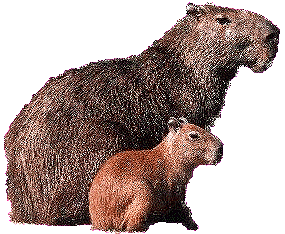
Why I’m Selling CAPIBARA.COM
For 28 years, CAPIBARA.COM has been my digital home, a domain that played a role in the early internet’s evolution through URL cloaking, open-source projects, and capability security. As I transition to new ventures, I’ve made the difficult decision to offer this rare domain for sale. With its rich history, clean record, and versatile branding potential tied to the amazing capybara, CAPIBARA.COM is a unique opportunity for businesses, tech enthusiasts, or capybara lovers. Interested? Contact me at sales@capibara.com to make an offer.
A Piece of Internet History (1997–Present)
In this post I want to showcase a bit of that history to show potential buyers just what they would be buying.
Until recently, I had no plans to sell my 28-year-old domain. I assumed I’d keep it forever, but then after typing my domain name into domainindex and atom and discovering that CAPIBARA.COM has some real monetary value, I am reconsidering.
My divorce earlier this year left me in a tough financial spot, and the love of my life is trying with all her might to move back to her country and start a new business there, so with pain in my heart, because understandably the domain has sentimental value, I decided to see if I can sell it for a decent price.
After talking to a few LLMs and a few people from my past, it seems domainindex might be low in its appraisal of my domain given its history, while atom is likely to be above a realistic value unless I find a buyer who truly appreciates the value of this domain as a little piece of hidden early internet history.
Early URL cloaking service
In the late 1990s and early 2000s, many people were hosting personal web pages on sites like geocities, tripod and xoom. They were well known and free, but all of them had the users use rather long and non-memorable URLs. While there were affordable hosting options, most high profile hosting providers were quite expensive and next to that, they also usually charged for DNS hosting. There was granitecanyon though that could provide free DNS hosting.
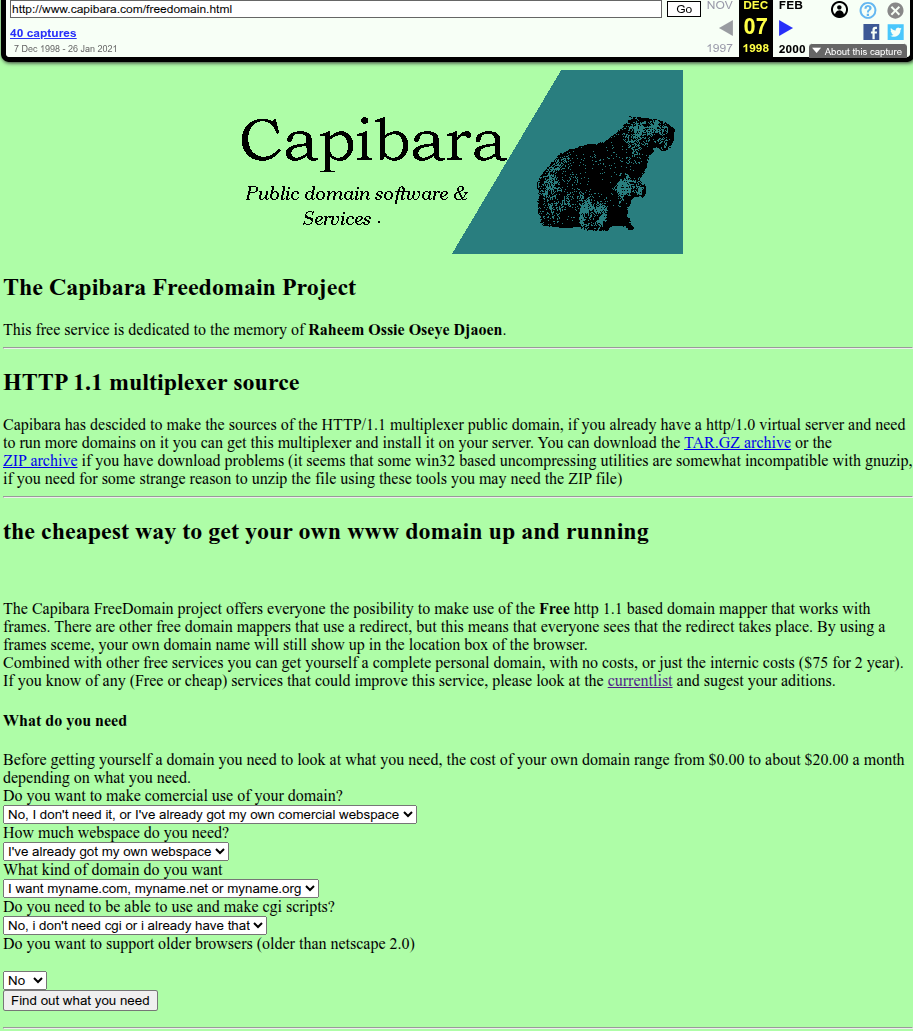
The Capibara site offered a cookbook for different needs. Depending on the input, the site advised the user to use specific free or cheap services.
It advised different services tailored for the user's needs. If needed it advised using budgetweb to go and find affordable hosting, and internic for domain registration, while advising different free services like geocities, xoom, or tripod for a free user webpage, granitecanyon for free DNS hosting, and CAPIBARA.COM itself for a free URL mapper.
A user could either choose a free op.nu subdomain, or set up their granitecanyon DNS to include a record that pointed to www.capibara.com
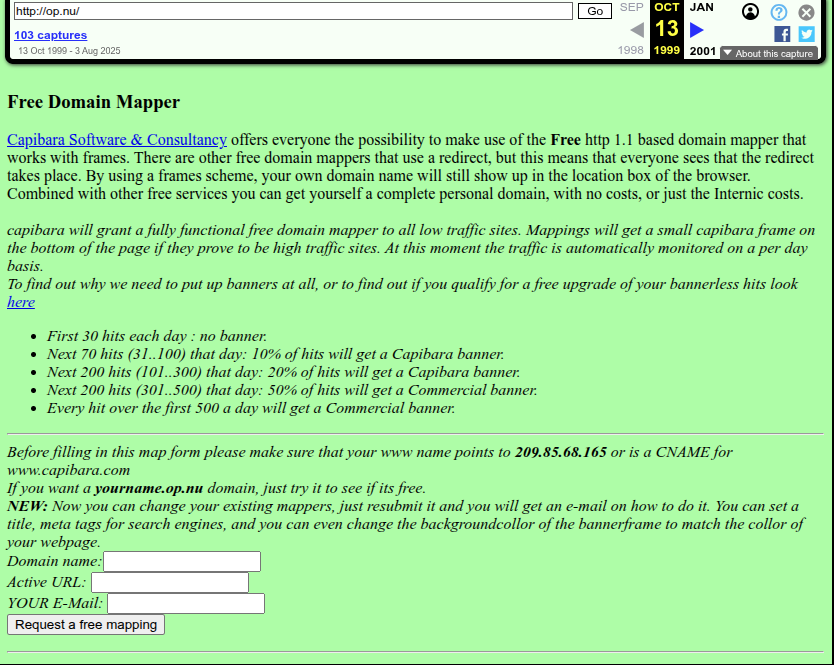
The combination of for example a free geocities user page with a paid for DNS registration at internic and free DNS hosting at granitecanyon including a CNAME entry pointing to capibara, would allow the CAPIBARA.COM URL cloaking service to create a single frame cloaking page.
The cloaking was free, but high traffic mappers would get a banner for a percentage of the users. 30 hits a day were banner free, then the banner count would slowly go up until anything after the first 500 hits on a single day would get a banner 100% of the time.
The TecForm CGI script
A second thing I used to host on CAPIBARA.COM was the open source CGI script TecForm. TecForm started out as a freelance development job for a small internet company. It was a CGI webform mailer like FormMail, but quite a bit more advanced. TecForm had an extensive templating and input validation framework integrated in a single script. When the internet company contracting me failed to pay me for my work for six whole months, I decided to just make the script open source. This was my first of many open source projects. This was in the time before github or even sourceforge, so I had to host the code myself on CAPIBARA.COM. It later moved to sourceforge, but CAPIBARA.COM was the place where all of my open source efforts ultimately began.
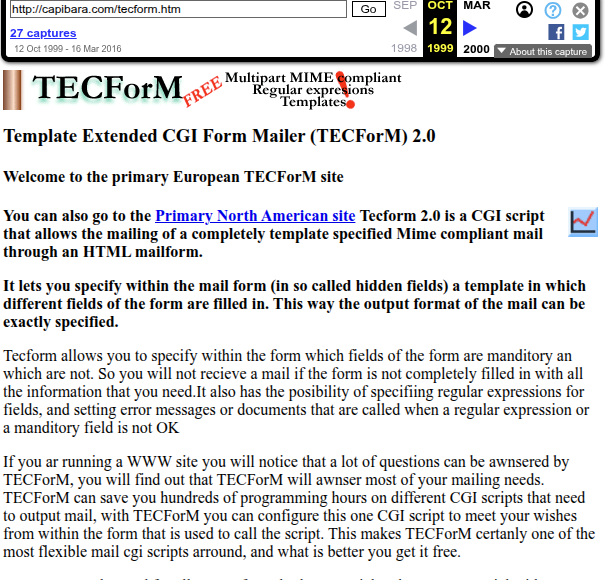
The Dot-Com Burst and Recovery
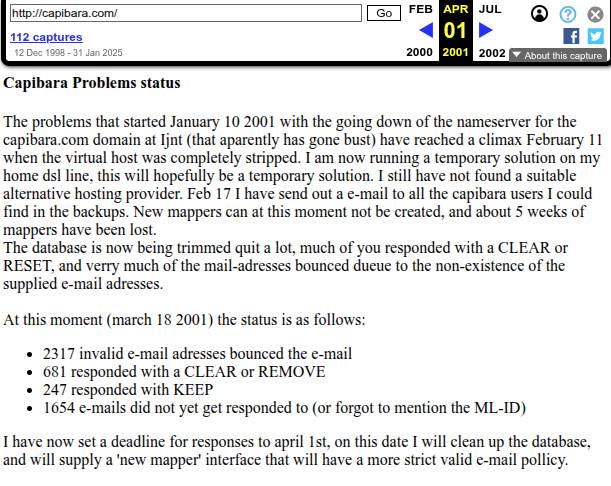
In 2001 the first major hiccup happened. My hosting provider, a US based company, Ijnt, went belly up in the dotCom burst.Thankfully I still had recent backups of the database.
Distributed CDuck and op.nu
Later in 2001 I started running the old URL cloaking service on an Apache server running on a system in my home in Haarlem in the Netherlands. I ran it through an xs4all ADSL connection without any redundancy. I was looking for people willing to run a mirror, but the setup was too complex, so none of the people who volunteered managed to set up the mirror and keep it running through sync ups.
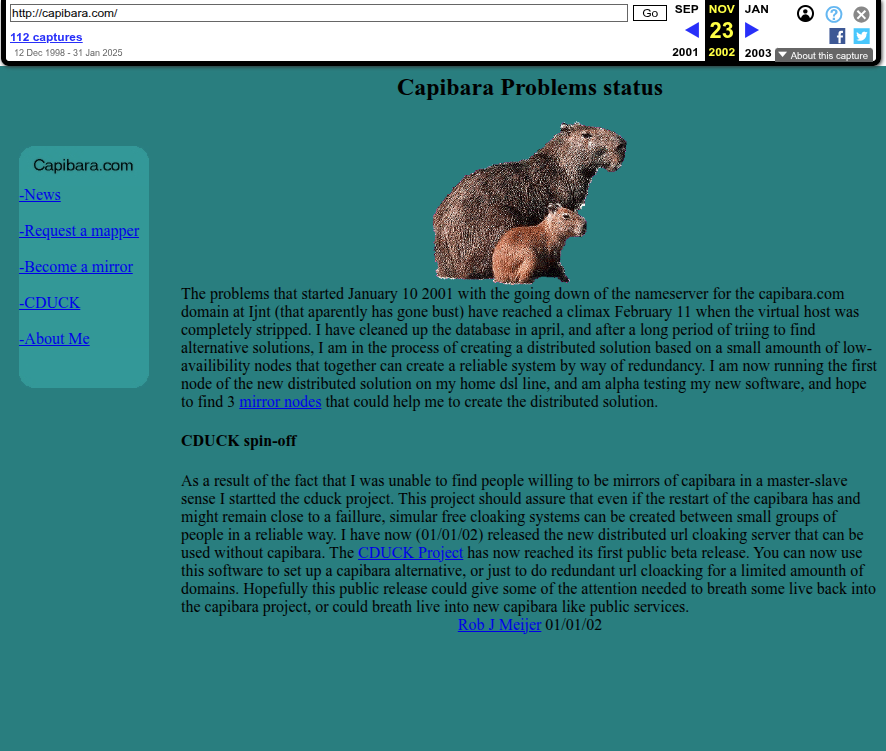
One year later in 2002, the original setup got frozen (no more new centrally managed mappers), and migration to the Capibara Distributed URL Cloaking Kit (cduck started).
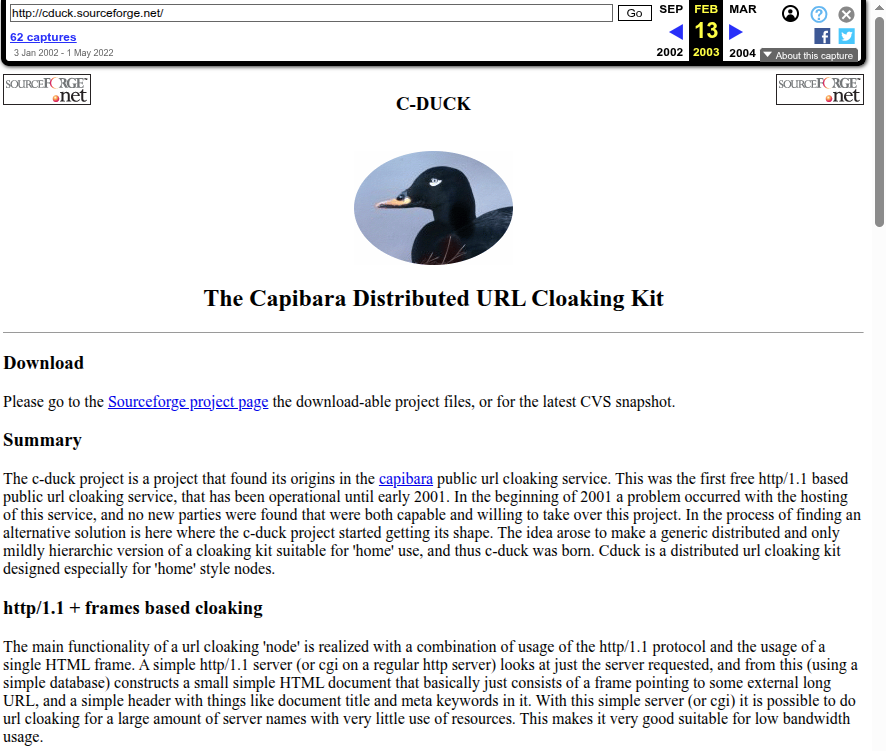
By 2003, CAPIBARA.COM and op,nu were both running on CDuck nodes.
Most of the time, with a few hiccups, the slimmed down user base kept running distributed just fine until 2007
In 2007 or 2008 (I can't find the exact date) the registrar for NU.NL, the domain that I used for giving away free subdomains for the URL cloaking service changed their pricing. Before I paid $25 a year for domain renewal, but in 2007 or 2008 the registrar decided it would be a good idea to mark op.nu as a premium domain, so instead of $25, renewal would cost me a few thousand instead. This repricing caught me totally off guard and I had no time to seek sponsors, so unfortunately I had to just let op.nu expire and with it all of the username.op.nu URL cloaking mappings died. Making up over 80% of the mappers, and with the already declining usage, this was the deadblow that made me abandon the CDUCK project.
Capability Security and MinorFS
By then I was deep into Capability Security. So the now unused domain became just a place for me to publish SUSE packages for MinorFS and some auxiliary stuff. MinorFS was a least authority file-system meant to work together with AppArmor, a security framework for the Linux kernel, to allow both least authority systems with small binary executables, making non-monolitic multi-process apps where each process is like an individually insecure but compositionally least authority actor, and alternatively allow object capability code written in the E programming language to be protected from attacks from below.
Not long later the main domain URL was used to redirect to my wordpress blog where I blogged about least authority and capability stuff.
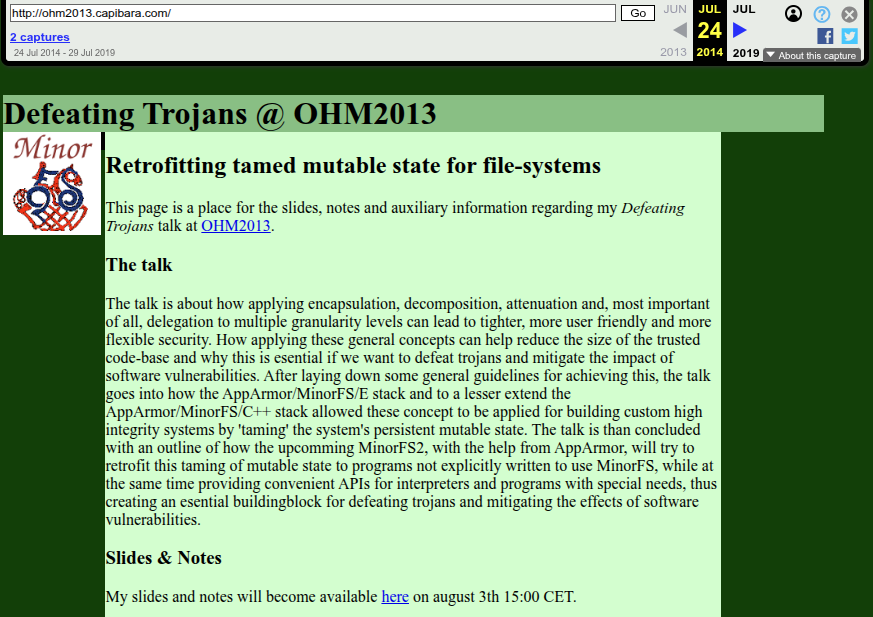
In 2013 I gave a talk on my further plans for MinorFS at the OHM2013, an outdoor hacker conference in the Netherlands.
In 2018 I stopped paying for hosting, and made the domain simply forward to my github page.
Capibara, Dutch and Spanish for Capybara
I hope that with the overview so far, it is clear that the domain CAPIBARA.COM comes with a rich piece of early internet history and a tiny bit of capability security and least authority history. But next to its rich history and its age, Capybaras are just amazing animals. The spelling Capibara is how Capybara is written in Dutch (I'm Dutch) and Spanish.

Make an offer
Trusted tools like domainindex and atom have appraised CAPIBARA.COM at significant values, with some estimates reaching well into the tens of thousands, reflecting its 28-year history and unique branding. I’m open to serious offers from buyers who see its potential You can reach me at sales@capibara.com.